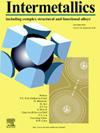冷轧AlNdTi合金靶材的组织、织构及晶粒细化机理:大变形促进动态再结晶
IF 4.8
2区 材料科学
Q2 CHEMISTRY, PHYSICAL
引用次数: 0
摘要
在本工作中,高纯AlNdTi合金(>;在直径为500mm的二辊轧机上,每道轧制厚度分别减少20%、40%、60%和80%,每次减少2mm。并对其显微组织、相分布、取向偏差、织构和显微硬度等性能进行了全面研究。结果表明,随着冷轧变形量的增大,AlNdTi合金的晶粒尺寸在80%变形时达到最小值18 μm。同时,相分布的发展表明,α-Al11Nd3的网状分布状态保持不变,但经过大的轧制变形后,其表面出现了微裂纹。此外,取向偏差结果表明,80%轧制AlNdTi合金中再结晶晶粒比例高达43.2%,而变形区比例仅为12.5%。80%轧制试样的高角率为34.2%,平均错向角为16.8°。此外,TEM观察到的直径为1 ~ 2 μm的亚晶和直径为3 ~ 5 μm的再结晶晶粒为高纯AlNdTi合金在轧制变形过程中发生动态再结晶提供了直接证据。并对晶粒细化机理进行了分析和探讨。此外,还详细分析了不同轧制变形条件下AlNdTi合金的织构发展。80%轧制AlNdTi合金的显微硬度最高可达45 HV,而铸态AlNdTi合金的显微硬度仅为23 HV。研究结果为液晶显示行业冷轧AlNdTi合金靶材的显微组织、相分布、织构演变等控制提供了新的视角。进一步阐明了动态再结晶对该合金靶件塑性变形行为的影响。本文章由计算机程序翻译,如有差异,请以英文原文为准。
The microstructure, texture and grain refinement mechanism of cold-rolled AlNdTi alloy target: Large deformation promotes dynamic recrystallization
In this work, the high pure AlNdTi alloys ( 99.99 wt%) were rolled to a total of 20 %, 40 %, 60 % and 80 % thickness reduction with a reduction of 2 mm during each pass by a two-high mill rolling machine with the roll diameter of 500 mm. Moreover, a comprehensive investigation was carried out to study their microstructure, phase distribution, misorientation, texture and microhardness properties. As a result, with the cold-rolled deformation increasing, the grain size of AlNdTi alloy reaches its minimum value of 18 μm at 80 % deformation. Meanwhile, the development of phase distribution shows that the reticular distribution state of -Al11Nd3 remains unchanged, but some microcracks appear on its surface after large rolling deformation. In addition, the misorientation results show that proportion of recrystallized grains in 80 % rolled AlNdTi alloy is as high as 43.2 %, while the proportion of deformed zone is only 12.5 %. Moreover, the percentage of high-angles of 80 % rolled sample is 34.2 % and the average misorientation angle is 16.8 . Besides, the subgrains with the diameter of 1∼2 m and recrystallized grains with the diameter of 3∼5 μm observed by TEM provide direct evidence that dynamic recrystallization occurred in high-purity AlNdTi alloys during rolling deformed process. And the grain refinement mechanism was analyzed and discussed. Furthermore, the texture development of AlNdTi alloy with various rolling deformation was analyzed in detail. Besides, 80 % rolled AlNdTi alloy has the largest hardness of 45 HV, while the microhardness of as-cast AlNdTi alloy is only 23 HV. In a word, these results can provide a new perspective on the control of microstructure, phase distribution, texture evolution, etc. of cold-rolled AlNdTi alloy target in liquid crystal display industry. Moreover, it is beneficial for clarify the generation of dynamic recrystallization on the plastic deformation behavior of this alloy target.
求助全文
通过发布文献求助,成功后即可免费获取论文全文。
去求助
来源期刊

Intermetallics
工程技术-材料科学:综合
CiteScore
7.80
自引率
9.10%
发文量
291
审稿时长
37 days
期刊介绍:
This journal is a platform for publishing innovative research and overviews for advancing our understanding of the structure, property, and functionality of complex metallic alloys, including intermetallics, metallic glasses, and high entropy alloys.
The journal reports the science and engineering of metallic materials in the following aspects:
Theories and experiments which address the relationship between property and structure in all length scales.
Physical modeling and numerical simulations which provide a comprehensive understanding of experimental observations.
Stimulated methodologies to characterize the structure and chemistry of materials that correlate the properties.
Technological applications resulting from the understanding of property-structure relationship in materials.
Novel and cutting-edge results warranting rapid communication.
The journal also publishes special issues on selected topics and overviews by invitation only.
 求助内容:
求助内容: 应助结果提醒方式:
应助结果提醒方式:


